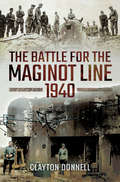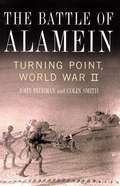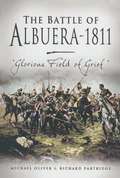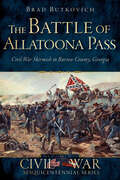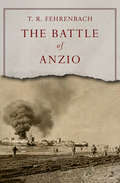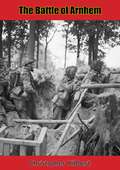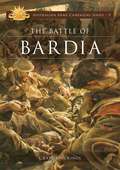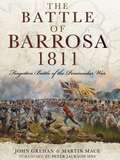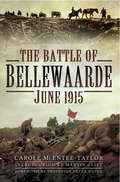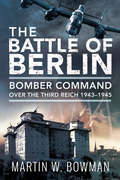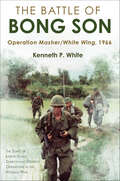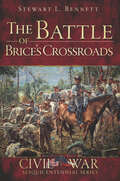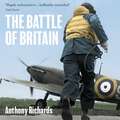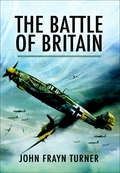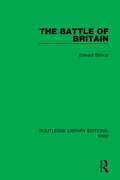- Table View
- List View
The Battle for the Maginot Line, 1940
by Clayton DonnellWhat was it like as a French soldier to defend the Maginot Line when the Germans invaded in 1940, and was the line really a strategic and tactical disaster a massive waste of resources? Clayton Donnell's expert, finely detailed and graphic account of the role of the Maginot Line in the defense of France gives the reader an inside view of life in the bunkers, casemates and forts the sights, the sounds and the terror of the German attacks. And it questions common assumptions about the effectiveness of the resistance offered by the defenders and the impact the line had on the German assault. The layout of the line from Dunkirk to Switzerland, along the Alpine passes to the Riviera, and on the island of Corsica is described in expert detail, as is its history, construction and development. But the narrative concentrates on its performance in combat and the experience of the soldiers who manned it as the German offensive broke over them.
The Battle of Alamein: Turning Point, World War II
by John Bierman Colin SmithA new perspective on the important battle of Alamein drawing on hitherto unpublished material
The Battle of Albuera 1811: Glorious Fields of Grief
by Michael Oliver Richard PartridgeOn 16 May 1811 a combined British, Portuguese and Spanish force commanded by the British general Beresford met the French army under Soult at Albuera in southern Spain. What followed was one of the bloodiest and most controversial battles of the Peninsular War. Yet despite the battle's significance in the wider campaign to expel Napoleon's armies from Spain, the story of Albuera has rarely received the coverage accorded to other battles of the war. In this ground-breaking book, Michael Oliver and Richard Partridge seek to set the historical record straight. They examine the carnage of Albuera in unprecedented detail, and they give a lucid account of the circumstances and the conflicting allied and French strategies that gave rise to this awful confrontation. They also offer vivid portraits of the personalities and military skills of the notable commanders who took part.
The Battle of Allatoona Pass: Civil War Skirmish in Bartow County, Georgia (Civil War Ser.)
by Brad ButkovichA Civil War historian explores one of the conflict&’s most dramatic and significant yet overlooked battles. In the 1840s, engineers blasted through 175 feet of earth and bedrock at Allatoona Pass, Georgia, to allow passage of the Western & Atlantic Railroad. Little more than twenty years later, both the Union and Confederate armies fortified the hills and ridges surrounding the gorge to deny the other passage during the Civil War. In October 1864, the two sides met in a fierce struggle to control the iron lifeline between the North and the recently captured city of Atlanta. Though small compared to other battles of the war, this division-sized fight produced casualty rates on par with or surpassing some of the most famous clashes. In this expertly researched volume, Brad Butkovich explores the controversy, innovative weapons and unwavering bravery that make the Battle of Allatoona Pass one of the war's most unique and savage battles.
The Battle of Anzio
by T. R. FehrenbachA major turning point of WWII: The incredible true story of Allied forces who held a strip of Italian beach against Nazi bombardment. The Battle of Anzio was among the most bloody of the World War II conflicts. T. R. Fehrenbach&’s accurate account stunningly depicts the reality of the Allied forces&’ fight for survival on an Italian beach as they stormed what Winston Churchill called the soft underbelly of the Axis powers. In one of the turning points of the war, the allies clung to a narrow strip of sand while German planes swooped in from above and artillery shells and mortar fire pounded them on the ground. This is a true and dramatic account of the battle from the perspective of a soldier and military historian, told with pride, compassion, and spirit. T. R. Fehrenbach&’s account of war needs no embellishing and brings you into the thick of the action.
The Battle of Ap Bac
by Neil SheehanAn eBook short.In the opening years of the Vietnam War, a small group of American military advisors and their South Vietnamese allies were facing down the Viet Cong. The confident Americans were there to do what seemed elementary: help the South Vietnamese army defeat a ragtag guerrilla enemy. They were assured of swift success. But one officer, John Paul Vann, saw darker omens for the future--and in the Battle of Ap Bac, the Viet Cong proved him correct.Encapsulating the great terrors, mistakes, ironies, and courageous acts of the Vietnam War, "The Battle of Ap Bac" recounts the clash in which the Viet Cong first won their spurs. It is an exciting, terrifying, fast-paced portrait of close-contact warfare in the rice paddies, the story of John Vann's attempt to singlehandedly change the terms of battle and avoid the relentless killing grounds of Vietnam that lay ahead. A key selection from Neil Sheehan's masterpiece, A Bright Shining Lie--which remains the preeminent history of the Vietnam War--it offers a prescient warning for current conflicts between powerful forces and underestimated foes.
The Battle of Arginusae: Victory at Sea and Its Tragic Aftermath in the Final Years of the Peloponnesian War (Witness to Ancient History)
by Debra HamelA harrowing, immersive introduction to a violent turning point in the conflict between Sparta and Athens.A pivotal skirmish involving nearly three hundred Athenian and Spartan ships toward the end of the Peloponnesian War, the Battle of Arginusae was at the time the largest naval battle ever fought between warring Greeks. It was a crucial win for the Athenians, since losing the battle would have led to their total defeat by Sparta and, perhaps, the slaughter and enslavement of their entire population. Paradoxically, the win at Arginusae resulted in one of the worst disasters to befall the Athenians during the brutal twenty-seven-year war.Due to a combination of factors—incompetent leadership, the weariness of the sailors, a sudden storm—the commanders on the scene failed to rescue the crews of twenty-five Athenian ships that had been disabled during the battle. Thousands of men, many of them injured, were left clinging to the wreckage of their ships awaiting help that never came. When the Athenians back home heard what had happened, they deposed the eight generals who had been in command during the battle. Two of these leaders went into exile; the six who returned to Athens were tried and eventually executed.The Battle of Arginusae describes the violent battle and its horrible aftermath. Debra Hamel introduces readers to Athens and Sparta, the two thriving superpowers of the fifth century B.C. She provides a summary of the events that caused the long war and discusses the tactical intricacies of Greek naval warfare. Recreating the claustrophobic, unhygienic conditions in which the ships' crews operated, Hamel unfolds the process that turned this naval victory into one of the most infamous chapters in the city-state's history. Aimed at classics students and general readers, the book also provides an in-depth examination of the fraught relationship between Athens' military commanders and its vaunted sovereign democracy.
The Battle of Arnhem
by Christopher HibbertIn this book, first published in Christopher Hibbert, one of Britain’s foremost historians, tells the true story of the Battle of Arnhem which was fought in September 1944 on Dutch soil and made famous in the 1977 film A Bridge Too Far.Nine thousand men of the First British Airborne Division were parachuted into the peaceful countryside that surrounded Arnhem. Their objective was to capture and hold the bridge over the Rhine ahead of the advancing British Second Army. Nine days later, after some of the fiercest street-fighting of the war, 2,000 paratroopers managed to escape to safety. This is the vivid account of how a brilliant plan turned into an epic tragedy.‘Alive with the detail that evokes the smoking background’—Daily Telegraph‘Finely recorded...truly the battle of Arnhem has been fortunate in its historian’—Sunday Times‘Clear-sighted, well written and scrupulously fair…it deserves to stand with the best of the battle chronicles’—Sunday Telegraph
The Battle of Arnhem: The Deadliest Airborne Operation of World War II
by Antony BeevorThe prizewinning historian and internationally bestselling author of D-Day reconstructs the devastating airborne battle of Arnhem in this gripping new account.On September 17, 1944, General Kurt Student, the founder of Nazi Germany's parachute forces, heard the groaning roar of airplane engines. He went out onto his balcony above the flat landscape of southern Holland to watch the air armada of Dakotas and gliders, carrying the legendary American 101st and 82nd Airborne Divisions and the British 1st Airborne Division. Operation Market Garden, the plan to end the war by capturing the bridges leading to the Lower Rhine and beyond, was a bold concept, but could it have ever worked? The cost of failure was horrendous, above all for the Dutch who risked everything to help. German reprisals were pitiless and cruel, and lasted until the end of the war. Antony Beevor, using often overlooked sources from Dutch, American, British, Polish, and German archives, has reconstructed the terrible reality of the fighting, which General Student called "The Last German Victory." Yet The Battle of Arnhem, written with Beevor's inimitable style and gripping narrative, is about much more than a single dramatic battle--it looks into the very heart of war.
The Battle of Ball's Bluff: All the Drowned Soldiers (Civil War Series)
by Bill HowardThree months after the Civil War's first important battle at Manassas in 1861, Union and Confederate armies met again near the sleepy town of Leesburg. What began as a simple scouting mission evolved into a full-scale battle when a regiment of Union soldiers unexpectedly encountered a detachment of Confederate cavalry. The Confederates pushed forward and scattered the Union line. Soldiers drowned trying to escape back to Union lines on the other side of the Potomac River. A congressional investigation of the battle had long-lasting effects on the war's political and military administration. Bill Howard narrates the history of the battle as well as its thorny aftermath.
The Battle of Bardia (Australian Army Campaigns #9)
by Craig StockingsOn the morning of 3 January 1941, Australians of the 6th Division led an assault against the Italian colonial fortress village of Bardia in Libya, not far from the Egyptian-Libyan frontier. The ensuing battle was the second of the First Libyan Campaign, but the first battle of the Second World War planned and fought predominantly by Australians. The fortress fell to the attackers a little over two days after the attack began, in what could only be described as a remarkable victory. At a cost of 130 killed and 326 wounded, the 6th Division captured around 40,000 Italian prisoners and very large quantities of military stores and equipment. The victory was heralded at the time in Australia as one of the greatest military achievements of that nation's military history. Quite soon afterwards, however, overshadowed perhaps by Rommel's subsequent desert advances, the tragedy in Greece, and the war in the Pacific, Bardia slipped from the public mind. Very few Australians today have heard of the battle. This book attempts to bring Bardia back into the light.
The Battle of Barrosa: Forgotten Battle of the Peninsular War
by Martin Mace John GrehanBy the winter of 1810-11, the armies of Napoleon had overrun most of Spain and Joseph Bonaparte sat on the throne in Madrid. But the Spanish Government had found refuge in the fortress-port of Cadiz and the Spaniards refused to admit that they had been conquered. With a British army under Sir Thomas Graham helping to defend Cadiz, the Spanish cause seemed certain to prevail.But then the Spaniards wanted to throw Graham's force into a reckless battle against the French. If the battle was won, the siege of Cadiz would be lifted; if the battle was lost Cadiz would be rendered defenseless and the Spanish government left at the mercy of the invaders.The opposing forces met on the heights of Barossa in one of the most savage encounters of the Peninsular War. At stake was the very survival of the Spanish nation and the future course of the war against Napoleon.The Battle of Barossa is the first book to examine this crucial campaign in detail and to reveal its true historical importance.
The Battle of Bellewaarde, June 1915
by Carole McEntee-TaylorIt was 2am on the 16th June 1915 and dawn was slowly breaking over Bellewaarde. It was exceptionally quiet, the troops of 3rd Division were situated on the western edge of Railway Wood and shrouded in a thick mist which reduced visibility and gave the illusion of safety. Across the few yards of no man's land, the German troops of Reserve Infantry Regiments (RIR) 248 and 246, and Unter-Elsssisches Infanterie-Regiment Nr. 132 were also blanketed in the thick damp mist. It swirled round their trenches, deadening sound and reinforcing the illusion that all was secure. Fifty minutes later the planned British artillery bombardment began. By the end of the day more than 4,000 men would be casualties on a field approximately half a mile square. At the close of the 2nd Battles of Ypres, the German trenches between the Menin Road and the Ypres-Roulers railway formed a salient. From Bellewaarde ridge, situated on the eastern side of the lake, they were able to overlook the greater part of the ground east of Ypres. In early June it was decided to attack the salient, and take possession of Bellewaarde ridge. The attack was to be carried out by the 9th Brigade of the 3rd Division, with 7th Brigade in support.The book is a tribute to those who fought and died at Bellewaarde on the 16th June 1915 and author royalties will be donated to a fund to help raise money for a memorial.
The Battle of Berlin 1945
by Tony Tissier‘Tony Le Tissier is arguably the finest English-language historian of the Battle of Berlin’ defenceWebThe Battle of Berlin was a battle on an unprecedented scale. The Soviets massed 1.6 million troops forOperation Berlin, and Marshal Zhukov in the centre had half of them, but his initial attack floundered, lasting four days instead of one. It was so costly that he had to revise his plans for taking the city, and to revise them yet again when Stalin allowed his rival, Marshal Koniev, to intervene. The battle thus became a contest for the prize of the Reichstag. Meanwhile, Hitler and his courtiers sought to continue the struggle in the totally unrealistic atmosphere that prevailed in his bunker, while soldiers and civilians alike suffered and perished unheeded all around them.In The Battle of Berlin 1945, Tony Le Tissier brings us the definitive history of the last great battle of the Second World War – a fight to the death in the smouldering ruins of the capital of Hitler’s Third Reich.
The Battle of Berlin: Bomber Command Over the Third Reich, 1943–1945
by Martin W. Bowman&“A fascinating look into the aircrews used and the effect on those who had to live through this constant bombing&” by the RAF during World War II (UK Historian). Berlin was bombed by four Allied air forces between 1940 and 1945. British bombers alone dropped 45,517 tons of bombs, while the Americans a further 23,000 tons. By 1944, some 1.2 million people, 790,000 of them women and children, about a quarter of Berlin&’s population, had been evacuated to rural areas. An effort was made to evacuate all children from Berlin, but this was defeated by parents and many evacuees who soon made their way back to the city. However, by May 1945, 1.7 million people—40% of the population—had fled the city. This fitting tribute to those who died in the relentless struggle to knock Berlin, and hopefully Germany, out of the war resonates with eyewitness accounts and background information which the author has painstakingly investigated and researched. The result is a hugely fascinating and highly readable narrative containing very real and unique observations by British and Commonwealth aircrew and, equally importantly, the long-suffering citizens of Berlin, and well as the capital&’s defenders. Though not a defeat in absolute terms, in the operational sense The Battle of Berlin was an offensive that Air Marshal Sir Arthur Harris and his aircrews could not win. &“Berlin won&” concluded Sir Ralph Cochrane, the Air Officer Commanding 5 Group RAF Bomber Command. &“It was just too tough a nut.&”&“An impressively informative, deftly written, exceptionally well documented, and expertly organized history . . . a seminal work of original scholarship.&” —Midwest Book Review
The Battle of Betazed: Star Trek The Next Generation (Star Trek: The Next Generation)
by Charlotte Douglas Susan KearneyCounselor Deanna Troi and the crew of the USS Enterprise work to carry out a perilous and desperate plan to stop the invasion of her home planet of Betazed by the Dominion conquerors.In the darkest hours of the Dominion War, as the Federation&’s downfall seemed ever more certain, Jem&’Hadar and Cardassian forces conquered Betazed, the homeworld of Deanna Troi. Their victory sent shock waves through the Alpha Quadrant, and put the Dominion within striking distance of Vulcan, Andor, Tellar, and possibly Earth itself. To secure their position in the very heart of the Federation, the Cardassians begin constructing space station Sentok Nor in orbit of Betazed. The station is to serve as both the seat of the Dominion occupation and the site of horrific experiments by Cardassia&’s foremost exobiologist, the infamous Dr. Crell Moset. With Starfleet&’s forces spread too thickly in the ongoing struggle to retake Betazed outright, the USS Enterprise along with some old and new friends, is deployed to carry out a dangerous and desperate plan. But no matter what the outcome, the consequences could alter Betazed irrevocably, forcing Deanna Troi to choose between her world&’s survival and its very soul.
The Battle of Bong Son: Operation Masher/White Wing, 1966
by Kenneth P. WhiteFinalist, 2024 Army Historical Foundation Distinguished Writing Awards"...a deeply researched and comprehensive book, chronicles the battle in great detail, including all American and allied units involved and some of the enemy units of the NVA’s Sao Vong (Yellow Star) Division." — The VVA Veteran Operation Masher/White Wing targeted the regiments of the North Vietnamese Army Sao Vang Division operating in the Bong Son area in northeast Binh Dinh Province in central South Vietnam. The operation started on January 24, 1966, immediately after the Vietnamese New Year (Tet) and ended six weeks later. It was led by newly promoted Colonel Harold G. Moore, who as a lieutenant colonel commanded the 1st Battalion, 7th Cavalry in the battle of Landing Zone X-Ray in the Ia Drang Valley two months earlier. In 41 days of sustained fighting, the 1st Cav battled each of the three regiments of the Sao Vang Division, resulting in enemy losses of more than 3,000 KIA. This came at the cost of 199 Americans killed on the battlefield and 46 more who died in the crash of a U.S. Air Force C-123 aircraft en route to the battlefield, making it one of the deadliest battles of the entire Vietnam War. Operation Masher/White Wing was a success. The 1st Cav demonstrated that it had the firepower, mobility, and leadership to find the enemy and deliver a severe blow to it in terms of personnel and equipment losses and in forced evacuation from formerly “secure” base areas, seemingly proving the value of the search-and-destroy strategy. However within a few weeks, intelligence reports indicated that North Vietnamese soldiers were returning to the Bong Son area in small groups. By late April, the Sao Vang Division was back in the area in force. Operation Masher/White Wing proved to be the start of a very long and deadly struggle between the 1st Cav and North Vietnamese for control of Binh Dinh Province—multiple search & destroy operations eventually resulted in more than 9,000 enemy KIA and 2,358 enemy detained, with friendly losses of more than 1,200 KIA, 5,775 WIA, and 27 MIA. While Masher/White Wing demonstrated that search & destroy operations were very effective at the tactical level but without a high-level strategy to stop the unabated flow of fresh Communist troops and supplies into South Vietnam, it wasn’t clear just how they contributed to overall victory. At the start of 1968, General Westmoreland ordered the 1st Cav to terminate its operations in the Bong Son area, bringing the battle to a close.
The Battle of Borodino: Napoleon Against Kutuzov (Campaign Chronicles)
by Alexander MikaberidzeAlbert Balls individuality and his insistence on fighting alone set him apart from other fighter pilots during World War One. His invincible courage and utter determination made him a legend not only in Britain but also amongst his enemies, to whom the sight of his lone Nieuport Scout brought fear. In 1914 he enlisted in the British army with the 2/7th Battalion (Robin Hoods), of the Sherwood Foresters, Notts and Derby Regiment. By the October of 1914 he had reached the rank of Sergeant and then in the same month was made a Second-Lieutenant to his own battalion. In June 1915 he paid for private tuition and trained as a pilot at Hendon. In October 1915 he obtained Royal Aero Club Certificate and requested transfer to the Royal Flying Corps. The transfer granted, he further trained at Norwich and Upavon, being awarded the pilot's brevet on 22 January 1916. On 16 May 1916—flying Bristol Scout 5512—he opened his score, shooting down an Albatros C-type over Beaumont. On 29 May 1916 he shot down two LVG C-types, whilst flying his Nieuport 5173.Captain Albert Ball made his final flight on 7 May 1917 when he flew SE5 A4850 as part of an eleven-strong hunting patrol into action against Jagdstaffel 11, led by Lothar Von Richthofen. It was a very cloudy day. Albert was pursuing Lothar's Albatros Scout who crash-landed, wounded. Then Albert was seen by many observers to dive out of a cloud and crash. He died minutes later in the arms of a French girl, Madame Cecille Deloffre. He rose from obscurity to the top rank of contemporary fighter pilots in only 15 months. In that period he had been awarded the MC, DSO and two Bars and was credited with at least 44 victories. He was posthumously awarded the Victoria Cross.
The Battle of Brice's Crossroads (Civil War Series)
by Stewart L BennettThe history of this unexpected Confederate victory in Civil War Mississippi, told through a collection of first-person soldier accounts. An insignificant crossroads in northeast Mississippi was an unlikely battleground for one of the most spectacular Confederate victories in the western theater of the Civil War. But that is where two generals determined destiny for their men. Union general Samuel D. Sturgis looked to redeem his past military record, while hard-fighting Confederate general Nathan Bedford Forrest aimed to drive the Union army out of Mississippi or die trying. In the hot June sun, their armies collided for control of north Mississippi in a story of courage, overwhelming odds, and American spirit. In this book, Stewart Bennett retells the day&’s saga through a wealth of first-person soldier accounts. Includes photos
The Battle of Britain
by Anthony RichardsIn the summer of 1940, the Nazi Blitzkrieg had blown through much of western Europe, seizing control of territory right up to the French coast and preparing to invade Britain. Standing in their way was Fighter, Bomber and Coastal Commands and the Royal Navy, all determined to prevent invasion, fighting off enemy forces in the air and in the water to protect the British shores.Published to coincide with Battle of Britain Day in 2022, this audiobook tells the heroic story of those five months using interviews, documents and materials from the archive at IWM. Personal testimony from those who were there helps bring to life this truly unique retelling of one of the most important moments of the Second World War."Hugely authoritative [...], both the iconic and the unknown, alongside brilliantly researched writing." --Dan Snow(P)2022 Headline Publishing Group Limited
The Battle of Britain
by John Frayn TurnerThe Battle of Britain was one of the crucial conflicts in the history of civilisation. It started officially on 10 July 1940 and ended on 31 October 1940. Hitlers plans for the invasion of England were thwarted by two types of fighter aircraft, the Spitfire and Hurricane, and a relative handful of young pilots, The Few.This fine book tells the momentous story of this unequal struggle, from the key events leading up to it, by graphic day-by-day accounts recording the action and commentary on the strategy. The authors personal knowledge of key figures means that there are many thrilling first-hand accounts by the aces, such as Peter Townsend, Bob Standford Tuck, Douglas Bader, Richard Hillary, Sailor Malan and other great men.This well-rounded book covers the contributions of Fighter Commands three Groups (10, 11 and 12) as well as the key roles played by RAF and WAAF groundstaff without whose tireless efforts the Battle would have been lost. A superb book which is unlikely to be bettered in its class.
The Battle of Britain
by Kate Moore The Imperial War MuseumPublished in association with the Imperial War Museum in London to celebrate the 70th anniversary of the Battle of Britain, this book brings one of the most important battles of World War II to life. Lavishly illustrated with photographs, contemporary art and propaganda posters, and accompanied by numerous first-hand accounts, The Battle of Britain captures the reality and the romance of a defining chapter in British history. Moreover, it offers a detailed analysis of the events immediately preceding the battle, the key strategic decisions by opposing commanders that altered the course of the battle, as well as the development of criticial weaponry and defenses that dramatically changed the way aerial combat was fought.Moore's book pays tribute to visionaries such as R. J. Mitchell and Air Chief Marshall Lord Dowding, who ensured that, rather than simply a victory snatched from the jaws of defeat, this was a battle for which Britain's Fighter Command was uniquely prepared. Such preparation nearly guaranteed that although the British were vastly outnumbered, they could confidently counter the German fighter planes and bombers that darkened the skies throughout the summer of 1940. It was this small band of men and women, covered in detail in this title, that were the first to successfully oppose the seemingly unstoppable tide of the Nazi war machine, irrevocably altering the course of the rest of the war.
The Battle of Britain (Routledge Library Editions: WW2 #1)
by Edward BishopThis book, first published in 1960, is a close examination of the twelve most decisive weeks in British history. It looks at the responsibility of pre-war politicians for the preparedness of the air defence system, the conflicting views on the conduct of the battle on both sides, the attitude of the US, and the part played by such leading figures as Dowding, Park, Beaverbrook, Kesselring and Sperle.
The Battle of Britain Pocket Manual 1940
by Chris McNabA guide detailing the training and operations for the British pilots, ground crew, and anti-aircraft gunners during the World War II battle.In the summer of 1940, Britain stood alone. For three long months, brave young RAF pilots took off every day, ready to defend British skies against large-scale Luftwaffe raids. “The Few” were young, but they were trained and determined. Eighty years on, the last of the pilots to fly in the Battle of Britain are feted, and their part in World War II is widely remembered.This pocket manual covers the training that these young pilots would have had, and the air combat tactics they were taught to use against the German raiders. It also covers the role of the ground crews, control and command systems, anti-aircraft defenses, and radar and raid detection.
The Battle of Britain Story (The Story Series)
by Graham PitchforkThe summer of 1940 witnessed the greatest air battle in history, as the men Winston Churchill dubbed ‘The Few’ fought over the skies of Britain to prevent the Luftwaffe from gaining air superiority, which would have paved the way for Hitler to invade our island. Graham Pitchfork charts the development of the epic battle fought by Fighter Command as it reacted to the changes in the Luftwaffe’s strategy, reaching a climax on 15 September before finally coming to a conclusion in October 1940. In addition to the exploits of the pilots in the air, the contribution of the many ground organisations that played such a crucial role is also highlighted in this lavishly illustrated book. Air Commodore Graham Pitchfork is a well-known aviation author whose previous books include The RAF Day by Day and The RAF’s First Jet Squadron: 616 (South Yorkshire).
